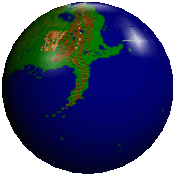 Óñensá
Cádezhyár - Planetary Data
Óñensá
Cádezhyár - Planetary Data Óñensá
Cádezhyár - Planetary Data
Óñensá
Cádezhyár - Planetary DataAluria circles a medium sized blue-white star on the edge of the Andromeda galaxy. The system consists of 10 planets and a small number of comets and other minor spacial bodies. Aluria is the innermost world, and the only one supporting life.
Aluria is at a distance of 347 million miles from its sun, which is inside the life-supporting area since its sun is both larger and hotter than Earth's. Although other worlds in the system have moons, some having several, Aluria itself does not. This has had various cultural implications on the Alurian people. For example, all references to the Moon in regards to romantic occasions have no meaning to them. Also, myths about the full moon such as lunacy, werewolves, etc., have equally little meaning.
Aluria circles its sun in 280 of its days, which in the Alurian calendar divides nicely into 10 months of 28 days each. Its day is approximately 35 Earth hours long, and is divided into 10 periods of 3.5 Earth hours, which in Aluric are called bhór (roughly hours). Each bhór is further divided into 10 peshár, and each peshár into 10 peshen. The Alurian day is considered to begin at sunrise with that moment being the start of bhór 1 (dwi) or the first hour.
The planet is slightly larger than Earth, with a diameter of 8100 miles. Its gravity 1.08 that of Earth. Its atmosphere is composed largely of the same elements as Earth, in slightly different quantities, but it would support Earth-type life indefinitely with no ill effects. However, the combination of slightly different elements in the atmosphere and Aluria's blue-white sun produce a pale purplish-lavendar sky color in place of Earth's pale blue, and cause sunrises and sunsets to glow with unfamilar colors such as purples, blues, greens, and yellows, in place of the reds and oranges terrans are used to.
The system sits slightly above the galactic plane, which affords Aluria with an excellent night-time view of Andromeda, especially in its central and southern latitudes. This view is only visible for half the year, the other half being filled with the emptiness of intergalactic space. These two extremes provide the major time measurement for Alurians, with the galaxy-viewing period being called Lhásketsvá and the empty period Lhányeszvá. Alurians celebrate the half-year points marking the beginning of each of these two periods with planet-wide festivals (Lháskyets and Lhányóen).
Aluria's axial tilt is minimal, less than 3 degrees, which means seasonal change is limited. The temperature rises slightly towards the equator, and falls as one approaches the poles, but in general remains in a range comfortable for life as we know it, varying between 40 and 100 degrees Fahrenheit. The polar regions themselves, being the area above 3 degrees latitude, are uninhabitably cold, but are entirely covered by ocean. The northern fringe of the main continent in the northern hemisphere, and several small barren islands in the far southern hemisphere, have a frost zone similar to the terran tundra, although these zones thaw each day and refreeze again each night.
Aluria is 80% covered by water. There is one major continent, Kániltóm, which almost wraps the entire globe in the northern hemisphere, missing by only 20% of the circumference. The other major land body is the island continent of Váyná, slightly smaller than Australia, in the southern hemisphere. There are numerous small islands and island chains scattered throughout the world ocean, some inhabited, some not.
Geographically and politically Aluria is divided into ten regions, each having its own prominent features which have influenced the culture in that area. Each region is in turn divided into provinces, the number of which varies from 2 in Geneshlìcá to 27 in Lyívná. The provinces represent the historical divisions within each region, dating back before the Enesnerrëvensës or Unification, when the current planetary government and culture were established.
Overall, the culture of the Alur remains remarkably homogeneous, in spite of their long history and independent spirit. Cultural and dialect differences do exist between regions and within regions between provinces, but there is a unity of spirit that has helped forge us into one single Alurian race.